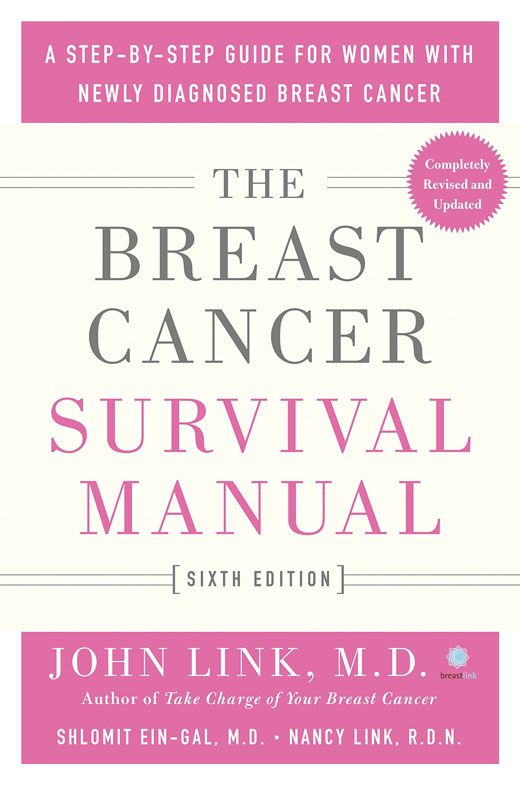The Breast Cancer Survival Manual by John Link, MD

Overview
John Link, M.D., a breast oncologist and founder of Breastlink, a multispecialty breast cancer diagnostic and treatment medical group, has updated the The Breast Cancer Survival Manual in its sixth edition. This edition expands on the breast cancer fundamentals included in previous editions by highlighting new and exciting advances in diagnostic tests, genomic tests and targeted therapies. Throughout the book, Dr. Link skillfully explains complex medical and scientific concepts in a way that is clear and easy to understand. The text includes helpful diagrams, treatment flow charts and practical tools to reinforce topics. The author combines his professional insights with the most recent scientific research in this comprehensive and accessible guide for the management of breast cancer.
How the book is organized
This book is divided into 15 chapters. Chapters 1-4 provide an introduction to breast cancer, advice on how to optimally prepare for treatment, a summary of different types of breast cancer and understanding the pathology report. Chapters 5-10 discuss types of treatment and management for specific types of breast cancer. Chapters 11-15 focus on risk assessment and genetic testing, nutrition and lifestyle, clinical research trials, survivorship and a conclusion. The book includes a helpful resource guide and glossary.
Introduction
This book serves as a “crisis manual” for women and men newly diagnosed with breast cancer. A diagnosis of breast cancer can bring fear, feelings of being overwhelmed and anxiety that often result in information seeking. The author encourages people to take the time to learn the latest credible and reliable medical information to make critical treatment decisions. Understanding treatment options is the best way to take control of one’s care, effectively collaborate with one’s healthcare team and achieve the best treatment outcome. Dr. Link states, “The main objective of this book is to educate you about breast cancer and to give you some control over what may now seem like chaos.” (p.7)
1- The Breast Cancer Basics
This chapter outlines the basics of breast cancer and illustrates the difference between normal cells and cancer cells. This chapter discusses cellular processes, DNA mutation, cancer cell reproduction, cancer growth rates (with a helpful diagram) and spread to the lymphatic system and bloodstream.
2- The Launching Pad (Knowledge is Power and Second Opinions)
The author explains local and systemic treatments and the importance of accurate diagnostic testing for treatment planning. He discusses how to take an organized approach in preparing for treatment, highlights the value of a second opinion and includes a valuable comparison tool for first and second opinion recommendations. This section lists helpful tips for getting the most out of doctor’s appointments.
3- Types of Breast Cancer
This chapter discusses the four distinct subtypes of breast cancer: Luminal A, Luminal B, Basal-Type (triple-negative) and HER2-positive. Advanced treatment options are available and depend on the specific subtype of breast cancer.
4- The Pathology Report
In this chapter the pathology report is explained in detail. Dr. Link provides an overview of cancer characteristics included on the report (diagnosis, microscopic description, clinical and gross description, grade, estrogen and progesterone receptors, HER2 receptor, Ki-67, and new genomic tests). This information identifies the subtype of breast cancer. The chapter provides a sample pathology report, discusses surgical pathology and closes with a TNM (T-tumor size, N-number of lymph nodes, M-metastasis) staging guide.
5- Local Control
Dr. Link defines local control as, “The complete removal of the primary cancer in the breast and any secondary spread to the adjacent lymph nodes in the axilla (armpit). The objective of local control is to remove the cancer in its entirety.” (p.61). This chapter discusses two main forms of local control: surgery and radiation therapy. Surgical approaches include lumpectomy, mastectomy and wide local excision. Dr. Link also conveys when preoperative (neoadjuvant) systemic treatment is indicated before surgery. The second half of the chapter focuses on the benefits and risks of radiation therapy and its role in preventing local recurrence. There is a section explaining different types of breast reconstruction.
6- Systemic Control
This chapter examines the types of systemic therapy used to treat the whole body, including chemotherapy drugs, antibody therapy and endocrine therapy. He discusses Tamoxifen, ovarian suppression and aromatase inhibitors. The chapter covers decision factors for chemotherapy, adjuvant and neoadjuvant chemotherapy and the side effects of various treatments. Clinical trials that have demonstrated the effectiveness of certain treatments are highlighted.
7- Ductal Carcinoma in Situ
This chapter is devoted to ductal carcinoma in situ (DCIS), or pre-invasive breast cancer that accounts for approximately 20% of newly diagnosed cases. Dr. Link defines DCIS, characteristics of DCIS and presents various treatment options for individuals with different levels of risk.
8- Management of Luminal Breast Cancer
This chapter discusses Luminal A and Luminal B breast cancer subtypes. The author examines prognosis, risk of recurrence and treatment options for each subtype. Hormonal therapy is discussed (preoperative and adjuvant settings), types of gene assay assessment for risk of recurrence and the role of chemotherapy. The author emphasizes the importance of a multi-disciplinary approach to treatment planning.
9- Management of HER2-Positive Breast Cancer
This chapter defines HER2-positive breast cancer, testing for HER2-positive disease, outlines options for local control and sequencing of treatment (chemotherapy and targeted antibody therapies such as trastuzumab and pertuzumab). Clinical trials that have contributed to the development of new treatments are featured.
10- Management of Triple-Negative Breast Cancer
This chapter includes characteristics of triple-negative breast cancer, neoadjuvant chemotherapy, the most effective drugs used for treating triple-negative breast cancer, gene profiling and subtypes of the disease. This chapter stresses the importance of participating in clinical trials.
11- Risk Assessment and Genetic Testing
Approximately 10% of women inherit a gene from one parent that increases their risk of developing breast cancer. The author examines BRCA1 and BRCA2 gene mutations, criteria for risk assessment and when genetic testing and counseling is appropriate. Other genes that are known to carry breast cancer risk are summarized in a clear table. Included is information on prophylactic mastectomies for high risk individuals and surveillance for people who are gene-positive but living without a diagnosis.
12-Nutrition and Lifestyle
The author highlights the concept of prehabilitation, or the time between diagnosis and beginning active treatment that can be an optimal time to make healthy lifestyle changes. Research has shown that patients who improve physical fitness before starting therapy actually handle treatment better and recover faster. This chapter includes information on risk factors for breast cancer (non-modifiable and modifiable), summarizes recent research on obesity and breast cancer risk and physical activity and cancer risk. Dr. Link presents approaches to eating a nutritious and healthy diet and addresses common supplements and alcohol consumption. One of the most valuable sections in this chapter focuses on how to create a healthy lifestyle plan. He states, “You are in control! And that can take you out of the patient mode and put you into active participant mode.” (p.143)
13- Clinical Research Trials
This chapter discusses the importance of clinical research trials, the four phases of clinical trial studies and offers national resources (National Cancer Institute) to learn more.
14- Life After Breast Cancer Diagnosis (Becoming a Survivor)
This chapter addresses many common concerns in survivorship, including long-term follow up and health surveillance, fear of recurrence, bone health, managing side effects from oral medications, sexuality, stress and breast cancer, alcohol consumption, financial concerns and advocacy.
15- Conclusion
This short chapter summarizes the importance of gathering accurate information about one’s diagnosis, getting a second opinion and making informed choices with treatment decisions.
Conclusion and Recommendation
In this book, Dr. Link examines the new genomic classification of breast cancer, the most advanced targeted treatments, local and systemic treatment options and the clinical research trials shaping the landscape of current and future breast cancer care. This information empowers readers with an understanding of their specific type of breast cancer, possible treatment options and the risks and the benefits of treatment decisions. Such a foundation will support individuals with having a more informed discussion with their breast oncologist, medical oncologist, radiation oncologist and treatment team. Dr. Link’s tone is refreshingly optimistic about contemporary treatment options due to developments in genomic testing and tailored therapies. As technological and scientific progress continues, we are on the cusp of even more promising methods to detect, cure and treat this disease. I highly recommend this book for anyone newly diagnosed with breast cancer. I also recommend this book to spouses, partners and loved ones seeking to better understand the nature of the disease. Most of all, this indispensible manual will support people to become their own best advocate in their care.
This book is 244 pages.
Reviewed by Alison Gause, MPH, CN-BA.

